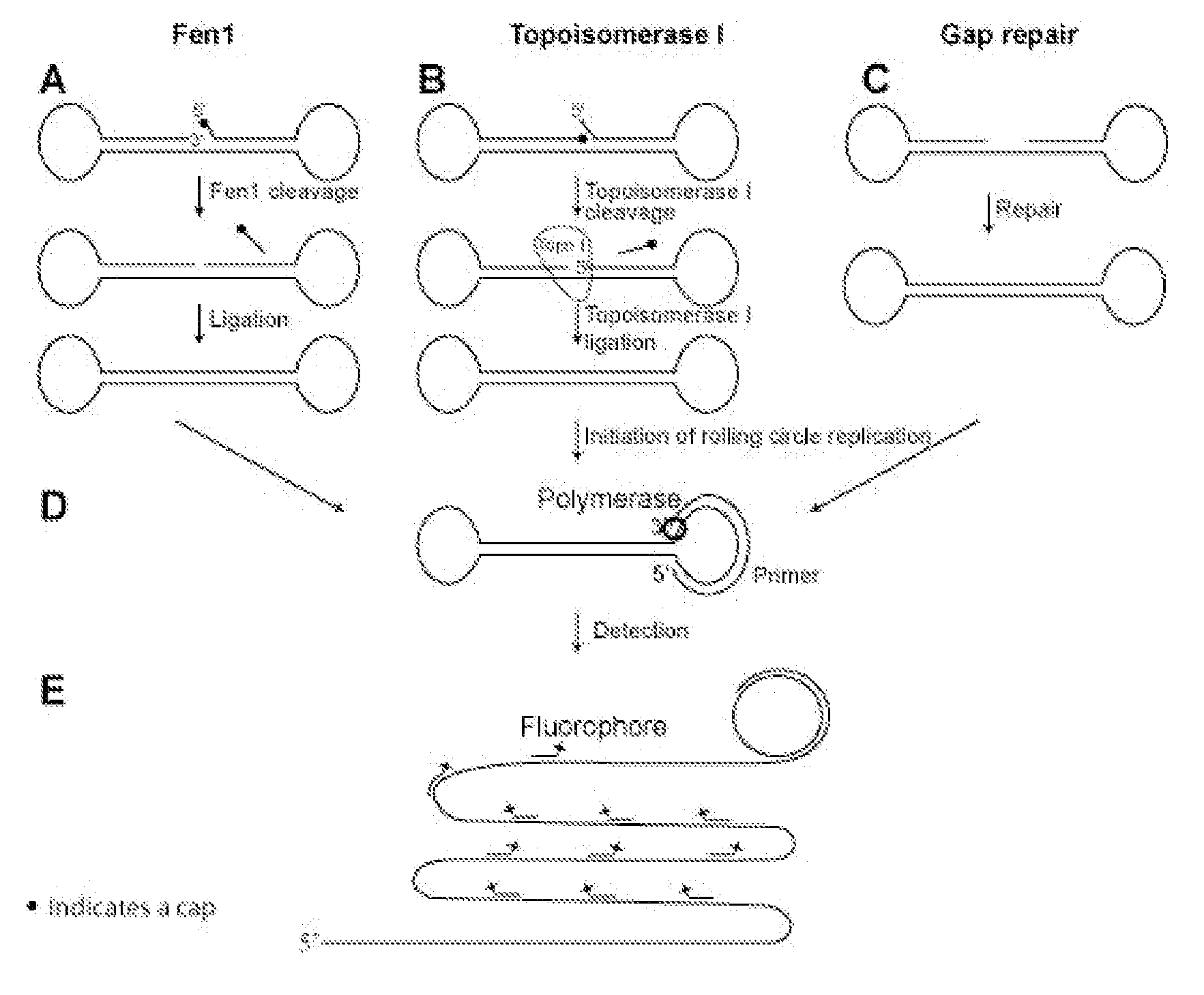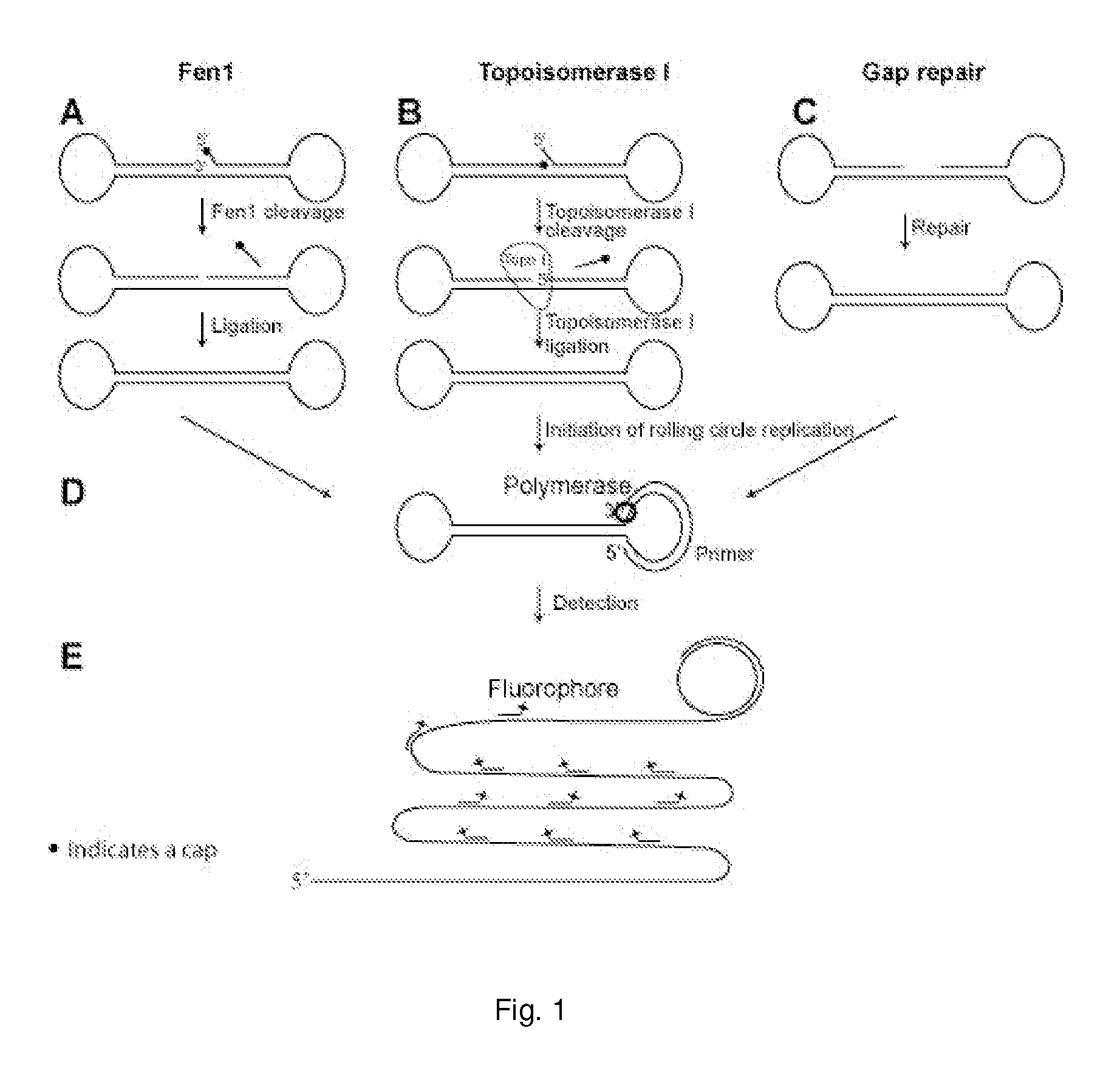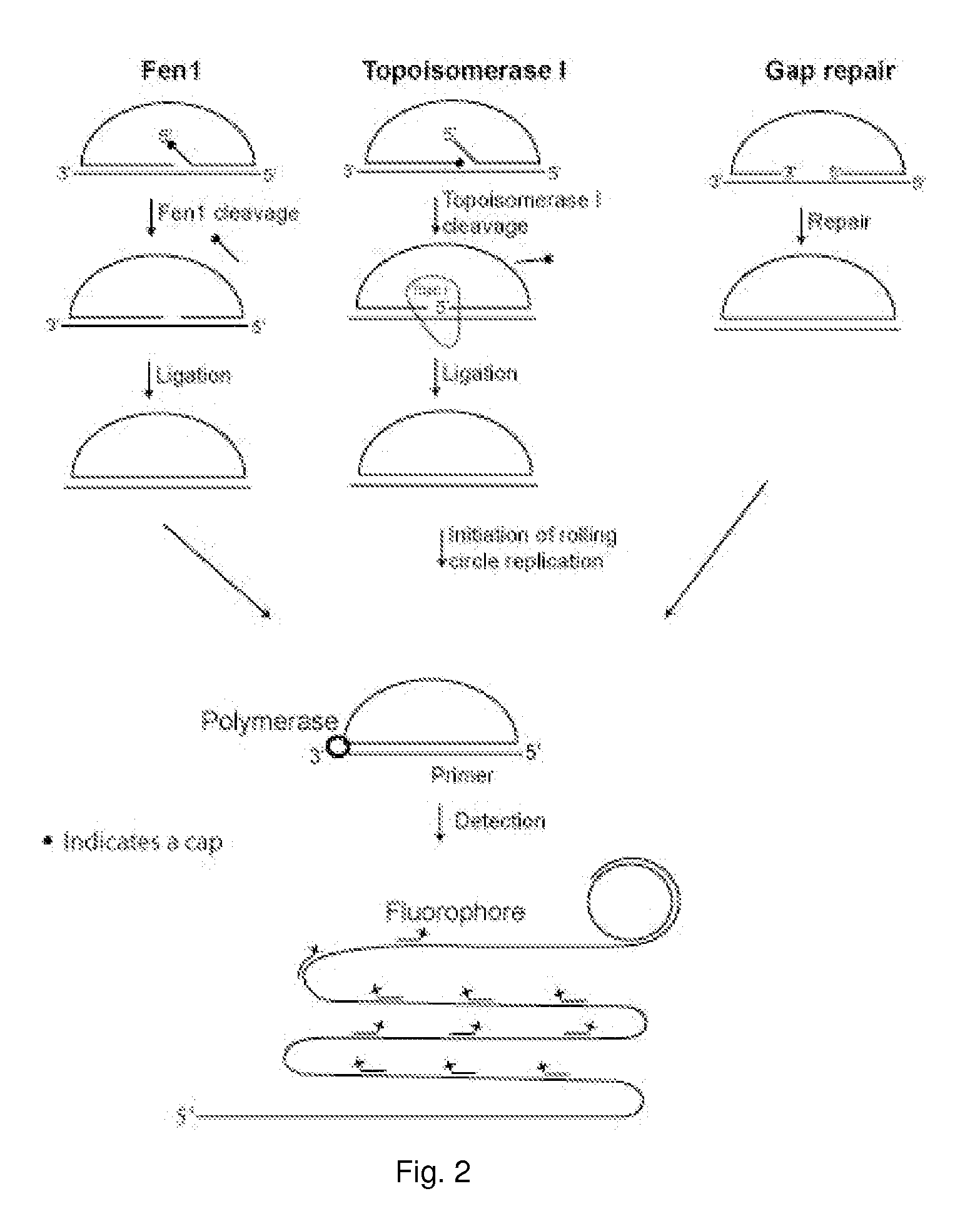Enzyme activity assay using rolling circle amplification
a technology of enzyme activity and assay, applied in biochemistry apparatus and processes, pharmaceutical non-active ingredients, biocide, etc., can solve the problems of inability to establish satisfactory correlation between protein production and corresponding protein activity levels, and the determination of biological processes which take place in a single cell requires multiple levels of labor and time-consuming investigations
- Summary
- Abstract
- Description
- Claims
- Application Information
AI Technical Summary
Benefits of technology
Problems solved by technology
Method used
Image
Examples
example 1
Methods
Oligonucleotides
[0322]Oligonucleotides (listed below) were purchased from DNA Technology A / S, Aarhus, Denmark.
NameSequenceFen15′-BIOTIN-GATATCGAAT TCCACTGTGA AGATCGCTTA TGGAATTCGATATCAAGCCC TCAATGCACA TGTTTGGCTC CGCTTGATAT-3′Fen15′-P-CGAATTCC ACTGTGAAGATCGCTTAT GGAATTCGAPOSTATCAAGC CCTCAATGCACATGTTTGGCTCC GCTTGATAT-3′Topo I5′-AGAAAAATTT TTAAAAAAAC TGTGAAGATC GCTTATTTTT TTAAAAATTTTTCTAAGTCT TTTAGATCCC TCAATGCTGC TGCTGTACTA CGATCTAAAAGACTTAGA-AMIN-3′Topo I5′-P-AGAAAAATTT TTAAAAAAAC TGTGAAGATC GCTTATTTTT TTAAAAATTTPOSTTCTAAGTCT TTTAGATCCC TCAATGCTGC TGCTGTACTA CGATCTAAAAA CTT-3′Primer15′-AMIN-CCAACCAACCAACCAA-ATAAGCGATCTTCACAGT-3′Primer25′-ATAAGCGATC TTCACAG-3′ID 165′-TAMRA-CCTCAATGCT GCTGCTGTAC TAC-3′ID 335′-FITC-CCTCAATGCA CATGTTTGGC TCC-3′
Fen1 Reaction
PAGE:
[0323]The Fen1 reaction was carried out in a mixture containing 40 mM Tris-HCl, pH 7.5, 10 mM MgCl2, 1 mM DTT, 0.2 μg / μl BSA, 0.1 μM probe, 30 pg / μl (1 fmol / μl) of Fen1 enzyme (Alexis Biochemicals), and 0.03 u / μl of T4 DNA ...
example 2
Gel-Based Detection Assays
Fen 1:
[0332]The experimental setup of the Fen1 activity assay was confirmed by PAGE (FIG. 2). The linear probe was degradable using a combination of exonuclease I and III (both exonucleases were used because the probe contained both single and double stranded regions) (compare FIG. 2, lane 1 and 2). The probe was also degradable when Fen1 and T4 DNA ligase were added separately (compare FIG. 2, lane 3 and 4 and lane 5 and 6). In contrast, when both Fen1 and T4 DNA ligase were included, a faster migrating product, resistant to exonucleases, appeared (compare FIG. 2 lane 7 and 8), indicating that the probe had been circularized. This circular product had the same migration speed as a circularized control probe with the same sequence as the Fen1 modified product (compare FIG. 2, lane 8 and 12). When only Fen1 was applied to the reaction, the linear product had a faster migration than without Fen1 (compare FIG. 2, lane 1 and 5), likely resulting from Fen1 remov...
example 3
Solid Support Amplification Assays
[0334]To verify that the resulting products were indeed circularized, solid support assays comprising RCR and fluorescent labeling were designed.
Fen1
[0335]Products corresponding to lane 1, 3, 5 and 7 from FIG. 2 were hybridized to a surface coated with 5′-amin-coupled oligonucleotides (primer 1). Following hybridization the covalently coupled oligonucleotide functioned as a primer for RCR. After amplification the products were detected by hybridizing a labeled oligonucleotide to the RCP. As expected, according to the gel-based assay, RCP's could only be detected when both Fen1 and ligase were present in the reaction mixture (FIG. 4). Since each Fen1 enzyme can prepare several probes for ligation, this assay does not correspond to single-molecule detection of Fen1 enzymes, but instead each green dot corresponds to a single circularization event (if two or more RCR reactions have not taken place in close proximity on the solid support, thereby giving ...
PUM
| Property | Measurement | Unit |
|---|---|---|
| temperature | aaaaa | aaaaa |
| time | aaaaa | aaaaa |
| time | aaaaa | aaaaa |
Abstract
Description
Claims
Application Information
 Login to View More
Login to View More - R&D
- Intellectual Property
- Life Sciences
- Materials
- Tech Scout
- Unparalleled Data Quality
- Higher Quality Content
- 60% Fewer Hallucinations
Browse by: Latest US Patents, China's latest patents, Technical Efficacy Thesaurus, Application Domain, Technology Topic, Popular Technical Reports.
© 2025 PatSnap. All rights reserved.Legal|Privacy policy|Modern Slavery Act Transparency Statement|Sitemap|About US| Contact US: help@patsnap.com



